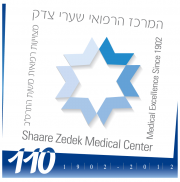הבדלים בין גרסאות בדף "טבלאות רגישויות מבית החולים שערי צדק - תרביות שתן - Shaare zedek medical center antibiotic sensitivity table - urine cultures"
מתוך ויקירפואה
| שורה 208: | שורה 208: | ||
|10||Staphylococcus aureus||61 (1)||37 (1)||24 (1)||1.20 (0.72-2.00)||0.477 | |10||Staphylococcus aureus||61 (1)||37 (1)||24 (1)||1.20 (0.72-2.00)||0.477 | ||
|- | |- | ||
| − | | || | + | | ||Total||4857 (92)||3156 (92)||1701 (92) || || |
|} | |} | ||
גרסה מ־10:31, 26 בספטמבר 2013
| שם הספר: שימוש מושכל באנטיביוטיקה ונהלים למניעת זיהומים | |
|---|---|

| |
| שם המחבר | פרופ' עמוס ינון, פרופ' יחיאל שלזינגר, דר' דוד רווה |
| שם הפרק | טבלאות רגישויות מבית החולים שערי צדק - תרביות שתן - Shaare zedek medical center antibiotic sensitivity table - urine cultures |
| מוציא לאור | |
| מועד הוצאה | תשע"א – 2010 |
| מספר עמודים | 196 |
| הקדשה | ספר זה מוקדש לפרופ' חיים הרשקו בהוקרה עמוקה |
Table 12: Urine cultures
Table 12a: Urine cultures, main isolates, by source of patients (2001-2008)
| Isolated organism | ≤48 hours in hospital
N=21833 |
>48 hours in hospital
N=9823 |
p |
|---|---|---|---|
| Acinetobacter | 237 (1) | 585 (6) | <0.001 |
| Enterobacteriaceae (total) | 15323 (70) | 5397 (55) | <0.001 |
| Citrobacter koserii | 499 (2) | 174 (2) | |
| Enterobacter cloacae | 411 (2) | 312 (3) | |
| E.coli | 8853 (40) | 1927 (20) | <0.001 |
| Klebsiella pneumoniae | 2132 (10) | 1371 (14) | <0.001 |
| Morganella morganii | 360 (2) | 192 (2) | |
| Proteus mirabilis | 1640 (7) | 762 (8) | <0.01 |
| Providencia stuartii | 196 | 131 | |
| Serratia marcescens | 77 | 52 | |
| Enterococcus sp. | 2467 (11) | 1833 (19) | <0.001 |
| Pseudomonas aeruginosa | 1404 (6) | 1263 (13) | <0.001 |
| Staphylococcus aureus | 394 (1) | 107 (1) | |
| Staphylococcus epidermidis | 686 (3) | 309 (3) | |
| Streptococcus | 707 (3) | 123 (1) | <0.001 |
| Group A | 22 | 4 | |
| Group B | 394 (2) | 50 (0.5) | <0.001 |
| Group D | 90 | 24 | |
| Group G | 12 | 3 | |
| S.viridans | 122 | 15 |
Table 12b: Antimicrobial susceptibilities (%) of Enterobacteriaceae isolated from urine cultures, 2000-2008
|
N |
≤48 hrs in hospital[1]
15316 |
>48 hours in hospital[1]
5397 |
|---|---|---|
| Penicillins | ||
| Augmentin | 65 | 51 |
| Tazocin | 92 | 82 |
| Cephalosporins | ||
| Cefazolin | 63 | 43 |
| Cefuroxime | 76 | 56 |
| Ceftriaxone | 84 | 66 |
| Ceftazidime | 84 | 67 |
| Cefepime | 86 | 69 |
| Carbapenems | ||
| Ertapenem | 99 | 96 |
| Imipenem | 99 | 98 |
| Aminoglycosides | ||
| Gentamicin | 85 | 69 |
| Amikacin | 98 | 94 |
| Other | ||
| Chloramph | 78 | 62 |
| Cotrimoxazole | 62 | 52 |
| Ciprofloxacin[2] | 76 | 60 |
| Colistin | 84 | 77 |
| Nitrofurantoin | 70 | 52 |
| ESBL-positive[3] | 15 | 32 |
Table 12c: Antimicrobial susceptibilities (%) of Pseudomonas aeruginosa isolated from urine cultures, 2001-2008
| ≤48 hrs in hospital[4] | >48 hours in hospital[4] | |
|---|---|---|
| Penicillins | ||
| Mezlocillin[4] | 77 | 73 |
| Tazocin | 92 | 88 |
| Cephalosporins | ||
| Ceftazidime | 92 | 89 |
| Cefepime[5] | 95 | 94 |
| Carbapenems | ||
| Imipenem | 94 | 91 |
| Meropenem[6] | 94 | 93 |
| Aminoglycosides | ||
| Gentamicin | 84 | 81 |
| Amikacin | 94 | 93 |
| Other | ||
| Ciprofloxacin | 73 | 69 |
| Colistin | 100 | 100 |
Table 12d: Ten most frequently isolated organisms from urine cultures and risk of isolation in presence and absence of urinary catheter (1st trimesters, 1990-2000)
| No. | Organism | Isolates
(n=5272) n (%) |
Catheter | RR[7]
(95% CI) |
P
value | |
|---|---|---|---|---|---|---|
| Absent
(n=3421) n (%) |
Present
(n=1851) n (%) | |||||
| 1 | Escherichia coli | 2540 (48) | 1822 (53) | 718 (39) | 0.73 (0.69-0.78) | <0.001 |
| 2 | Klebsiella pneumoniae | 574 (11) | 340 (10) | 234 (13) | 1.28 (1.09-1.49) | 0.002 |
| 3 | Pseudomonas aeruginosa | 469 (9) | 259 (8) | 210 (11) | 1.50 (1.27-1.79) | <0.001 |
| 4 | Enterococcus spp. | 418 (8) | 198 (6) | 220 (12) | 2.06 (1.72-2.47) | <0.001 |
| 5 | Proteus mirabilis | 333 (6) | 207 (6) | 126 (7) | 1.13 (0.91-1.40) | 0.265 |
| 6 | Staphylococcus coag (-) | 173 (3) | 124 (4) | 49 (3) | 0.73 (0.53-1.01) | 0.06 |
| 7 | Enterobacter cloacae | 129 (2) | 75 (2) | 54 (3) | 1.34 (0.95-1.89) | 0.099 |
| 8 | Acinetobacter baumanii | 88 (2) | 48 (1) | 40 (2) | 1.55 (1.02-2.34) | 0.04 |
| 9 | Citrobacter freundii | 72 (1) | 46 (1) | 26 (1) | 1.05 (0.65-1.69) | 0.846 |
| 10 | Staphylococcus aureus | 61 (1) | 37 (1) | 24 (1) | 1.20 (0.72-2.00) | 0.477 |
| Total | 4857 (92) | 3156 (92) | 1701 (92) | |||
Table 12e: Frequencies of isolation of selected Enterobacteriaceae, Pseudomonas and Enterococcus, according to source of patient (2001-2008).
הערות שוליים
- ↑ 1.0 1.1 Differences in rates of susceptibility between community and hospital acquired strains were significant for all antimicrobials (p<0.001).
- ↑ No significant changes in susceptibility % were noted over the study period.
- ↑ ESBL: extended spectrum beta-lactamase
- ↑ 4.0 4.1 4.2 continues to be tested
- ↑ tested until 2006
- ↑ tested since 2006
- ↑ Relative risk of organism isolation in the presence versus absence of a catheter.
ביבליוגרפיה
- Raveh D, Rudensky B, Huerta M, Aviv Y, Yinnon AM. Use of time-trend analysis in the design of empirical antimicrobial treatment of urinary tract infection. Eur J Clin Microbiol Infect Dis 2003; 22(3):158-64.
- Raveh D, Rosenzweig I, Rudensky B, Yinnon AM. Prospective, case control study to determine risk factors for community-acquired urinary tract infection due to Pseudomonas aeruginosa or Enterococcus. Eur J Clin Microbiol Infect Dis 2006; 25: 331-334.


 כניסה
כניסה  עקבו אחרינו בפייסבוק
עקבו אחרינו בפייסבוק 